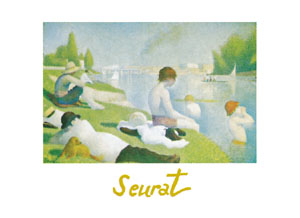Les Baigneurs Seurat

Poster Seurat Les Baigneurs - cm 50x70
| Cod | Dimensiuni în cm | Greutate pe mp |
Preț € |
Cant. comandă |
||
|---|---|---|---|---|---|---|
| Foaie | ||||||
Les Baigneurs Seurat -
Georges-Pierre Seurat (French pronunciation: [???? sø?a]; 2 December 1859 – 29 March 1891) was a French Post-Impressionist painter and draftsman. His large work A Sunday Afternoon on the Island of La Grande Jatte (1884–1886), his most famous painting, altered the direction of modern art by initiating Neo-impressionism, and is one of the icons of 19th century painting.
Life
Seurat was born into a wealthy family in Paris. His father, Antoine Chrysostom Seurat, was a legal official and a native of Champagne; his mother, Ernestine Faivre, was Parisian. Georges Seurat first studied art with Justin Lequien, a sculptor. Seurat attended the École des Beaux-Arts in 1878 and 1879. After a year of service at Brest Military Academy, he returned to Paris in 1880. He shared a small studio on the Left Bank with two student friends before moving to a studio of his own. For the next two years he devoted himself to mastering the art of black and white drawing. He spent 1883 on his first major painting — a huge canvas titled Bathers at Asnières.
After his painting was rejected by the Paris Salon, Seurat turned away from such establishments, instead allying himself with the independent artists of Paris. In 1884 he and other artists (including Maximilien Luce) formed the Société des Artistes Indépendants. There he met and befriended fellow artist Paul Signac. Seurat shared his new ideas about pointillism with Signac, who subsequently painted in the same idiom. In the summer of 1884 Seurat began work on his masterpiece, Sunday Afternoon on the Island of La Grande Jatte, which took him two years to complete.
Later he moved from the Boulevard de Clichy to a quieter studio nearby, where he lived secretly with a young model, Madeleine Knobloch, whom he portrayed in his painting "Jeune femme se poudrant". In February 1890 she gave birth to his son, who was given the first name of Pierre Georges. It was not until two days before Seurat's death that he introduced his young family to his parents.[citation needed]
Seurat died in Paris on 29 March 1891. The cause of Seurat's death is uncertain, and has been attributed to a form of meningitis, pneumonia, infectious angina, and/or (most probably) diphtheria. His son died two weeks later from the same disease.[2] His last ambitious work, The Circus, was left unfinished at the time of his death.
